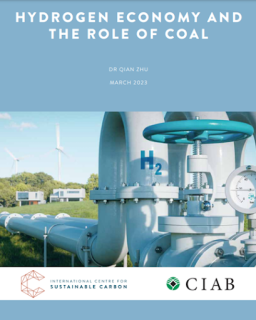-
Japan’s Green Innovation Fund selects J-Power/Sumitomo Corporation Joint Venture as preferred hydrogen producer
Date posted:
-
-
-
Post Author
Greg Kelsall
-
-

An Australian joint venture between Japanese organisations J-Power and Sumitomo Corporation (JPSC) has been selected as the preferred hydrogen provider to Japan Suiso Energy. The low-emissions hydrogen will be produced in Gippsland, Victoria and Japan Suiso Energy will liquify the hydrogen for export to Japan.
JPSC will produce the low-emissions hydrogen, derived from Latrobe Valley coal in Australia with carbon capture, utilisation and storage (CCUS). It represents the commercial demonstration phase of the previous Hydrogen Energy Supply Chain (HESC) pilot project, with a commitment of JP¥220 billion (approximately US$ 1.6 billion) in funding from the Japanese Government’s Green Innovation Fund. Based on Japan’s Green Development Strategy, the Green Innovation Fund was launched by the Ministry of Economy, Trade and Industry (METI) together with the New Energy and Industrial Technology Development Organisation (NEDO). With a budget of JP¥ 2 trillion (around US$ 16 billion), the fund aims to provide 10 years of continuous support to business-led decarbonisation initiatives, ranging from R&D and demonstration to social implementation, with specific goals shared between the public and private sectors.
As part of the previous HESC pilot project, J-Power have already produced 99.999% pure hydrogen from Latrobe Valley coal. This demonstrated a full hydrogen supply chain with the production of hydrogen as reported in a previous IFRF blog, and delivery of the hydrogen to the Port of Kobe in Japan in February 2022.
The new commercial demonstration project will initially produce between 30 to 40 kt H2/y. A future potential production of 225 kt H2/y would reduce about 1.8 Mt CO2/y from being released into the atmosphere according to the team. Subject to commercial agreements and meeting the required environmental permits and approvals, it is expected that hydrogen production will commence in the late 2020’s. The low-emissions hydrogen produced will comply with the Guarantee Origin Scheme for hydrogen being developed by the Australian Government in line with global hydrogen markets.
It will take advantage of one of several long-term CO2 storage solutions, including using the depleted oil and gas reservoirs in Bass Strait. The two carbon storage options under consideration are CarbonNet and ExxonMobil affiliate operated Gippsland Basin Joint Venture South East Australian Carbon Capture Storage Hub.
Jeremy Stone, Non-Executive Director of J-Power Latrobe Valley said; “building on the success of HESC and J-Power’s 166 MW Osaki CoolGen project, we are excited to be one step closer to making commercial scale hydrogen production in Victoria a reality. This is a major milestone and a recognition of Gippsland’s unique ability to help reduce global CO2 emissions through the reliable production of large quantities of cost competitive and clean hydrogen.” He further commented that “there is significant domestic interest in a reliable source of locally produced, cost competitive clean hydrogen. Now we have countries establishing the definition of “clean hydrogen”, based on carbon intensity, we are seeing an opening of trade, based on credible and transparent CO2 reduction numbers, at various price points. We are expecting further offtake agreements for hydrogen that can be used by a wide range of businesses and industrial processes, including the production of ammonia, fertiliser and methanol.”
Japan Suiso Energy CEO, Dr. Eiichi Harada said, “we are delighted to have selected the JPSC JV as the preferred supplier of clean hydrogen for the Japanese energy market as we continue our transition to a more sustainable clean energy future. We have received a commitment of JPY220 billion (AUD$2.35 billion) from the Japanese Government’s Green Innovation Fund to further progress this opportunity. We look forward to working with the JV and the Victorian, Australian and Japanese governments to achieve the significant economic and emission reduction benefits that a commercial scale clean hydrogen project will deliver.”
Overall context of the project- The Intergovernmental Panel on Climate Change (IPCC) and the International Energy Agency (IEA) both support CCUS as a necessary component of achieving net zero emissions by around 2050. According to the Global Carbon Capture and Storage Institute, there is now a pipeline of around 200 CCUS projects globally at various stages of development including 30 that are fully operational.
In terms of hydrogen production, a recent report from the International Centre for Sustainable Carbon shows that global demand for hydrogen is set to increase from about 94 MtH2/y in 2021 to more than 500 MtH2/y by 2050. Meeting this demand, in particular that for low-emissions hydrogen, will require the scaling up of production capacity in a short period of time from less than 1 Mt/y low-emission hydrogen in 2022.
Meeting this short- to long-term demand target for hydrogen is a huge challenge requiring rapid scaling up of hydrogen production capacity. The key challenges to address this include the large gap between the installed production capacity for renewable hydrogen and that required to meet governments targets, and the insufficient renewable power generation capacity to support large-scale renewable hydrogen production whilst meeting the direct need for electricity.
This means that the global demand for low-emissions hydrogen cannot be met by renewable hydrogen production alone, at least in the short to medium term. The report shows that hydrogen production from coal and natural gas with CCUS is essential to bridge the gap in meeting the demand. It also shows that low-emissions hydrogen from coal can offer a cost-competitive choice, supplementing other options in meeting the expected demand. This includes domestic demand in major hydrogen-consuming countries such as China and India but also in the global trade to provide importing countries with economically viable low-emissions hydrogen, such as the JPSC project described above.
![]()

